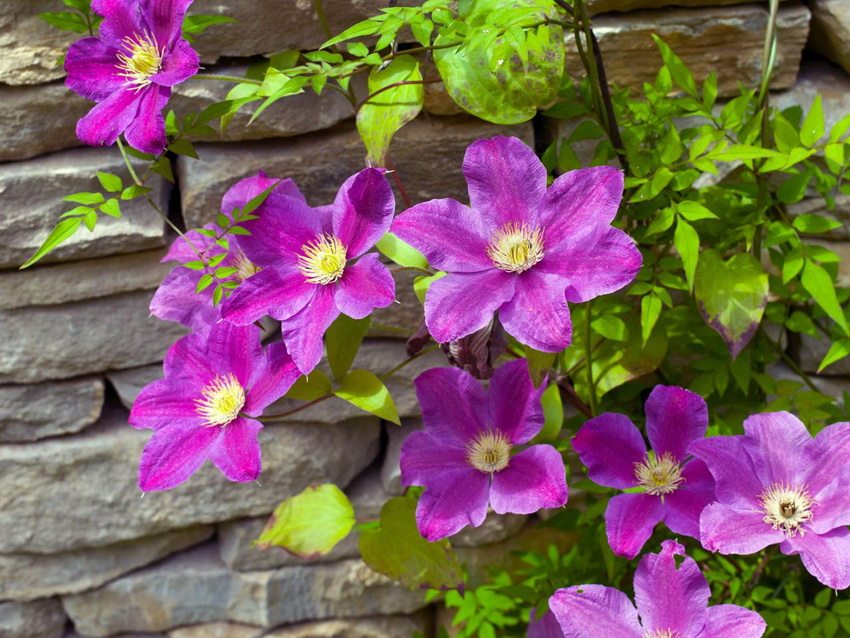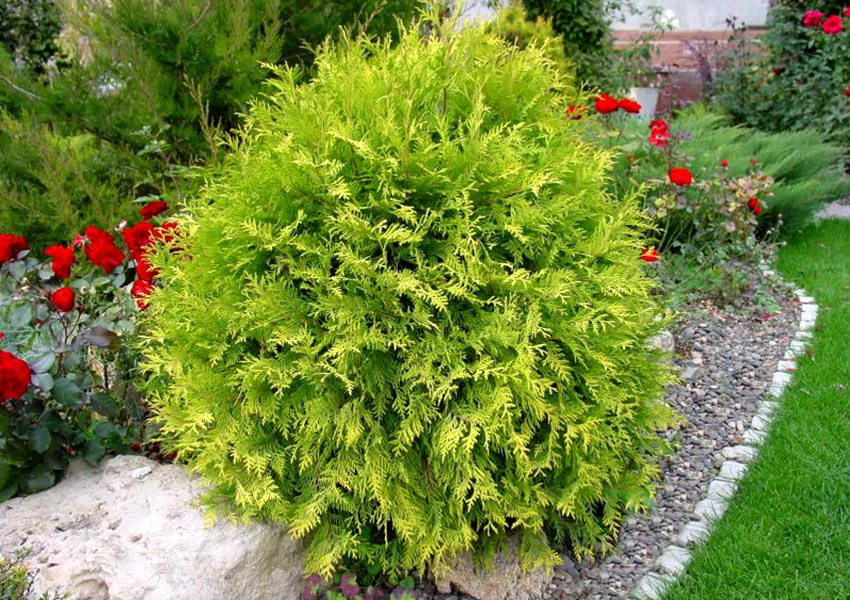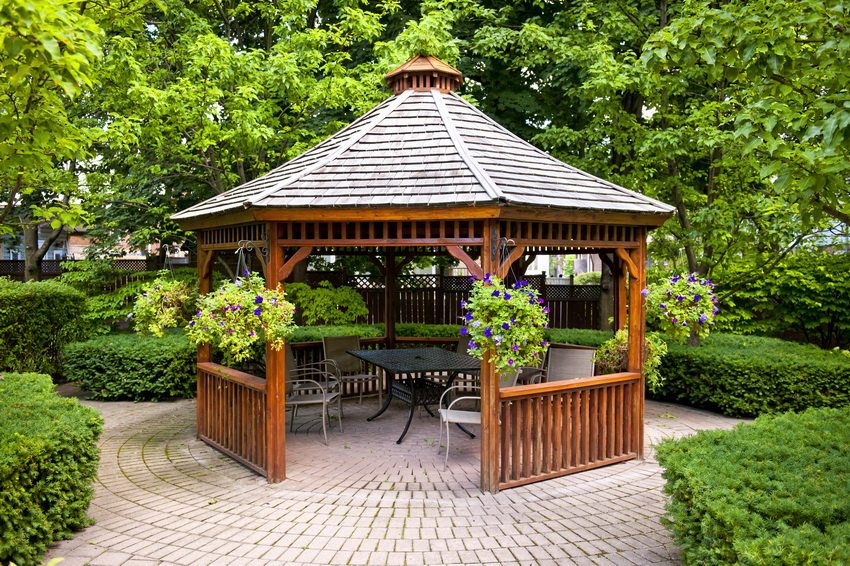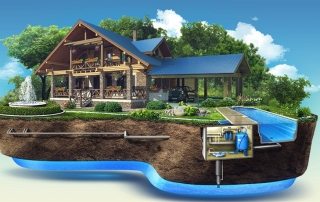In the city, with its intense pace of life and car smog, there are fewer and fewer places to be in nature and enjoy the fresh air. Salvation is a dacha where you can place and playground, and a gazebo for gatherings, beds or an orchard. It is not difficult to design the landscape design of a summer cottage of 10 acres with your own hands: photos and design tips will help create not only a functional place to relax, but also a real design masterpiece.
Content [Hide]
We create a landscape design for a summer cottage of 10 acres with our own hands: photos and ideas of the best projects
The area of a plot of 10 acres will be enough for the construction of all the necessary buildings, a vegetable garden and a garden with fruit trees, as well as for the implementation of your creative ideas for decorating a recreation area.
Professional landscape designers start their work with a project. Let's follow their example. First you need to draw a diagram of the suburban area with the application of all buildings and communications. Then determine the functional areas: for recreation and household needs (outbuildings, beds, vegetable garden). The size of the zones depends on the preferences and interests of the owners.
The condition of the soil, shade and relief of the territory must be taken into account when planning the landscape design of a country house. Photo diagrams will show the optimal solutions for the location of all elements.
The layout option depends on what functional purpose the owner determines the site. Consider the following variations:
- cottage for relaxation only. In this case, the entire territory is assigned to a recreation area. In this case, there is a place for a sauna and a garage for a car. Opposite the house, you can equip a playground and / or swimming pool. Gazebos, pergolas, patios will be a place for eating and relaxing in the fresh air. It is better to place them behind the house or to the side, protecting them from the entrance with a hedge. In terms of design, the territory is quite suitable for equipping an artificial pond, and multi-level alpine slides, and an artsy the fountain... It all depends on the imagination and financial capabilities of the owners;
- cottage for work. Option for lovers of home preservation. In this case, most of the territory (2/3) is allocated for beds, greenhouses, garden trees and shrubs.They need sunlight and water, so they have to take care of the possibility of watering. The southeast side would be the perfect place for them. The seating area is small. You can place a gazebo on it or a bench with a canopy, equip a flower bed and decorative compositions;
Useful advice! So that the watering hose does not have to be pulled across the yard, make plastic wiring in advance to water the beds, or break them near the water source.
- combined option - the most demanded in our time. At such a dacha you can work and relax. A place is allocated for small beds for fresh herbs and strawberries, which are made out by combined groups of ornamental plants. Several types of fruit trees, berry bushes are planted, and the remaining area is equipped with a recreation area. You can install a gazebo or a canopy on it, make a pond, vertical flower arrangements or a horizontal flower bed.
With a skillful approach and proper planning, you can equip all zones in a small summer cottage. The main thing is to decide what you need a summer residence for, and then you can expand some functional areas at the expense of others.
Seeing professional landscape design in photographs or in a neighbor's yard, many think that it is impossible to do it yourself. Learn the main points and be responsible and you will soon achieve the same result.
In order for the garden plot to always have a well-groomed and blooming look, it is necessary:
- think over the design style;
- choose the right type of landscaping and plants;
- think over the location and types of garden buildings and decorative structures.
Style direction
From large status dachas, designed by professional designers to order, sometimes it blows cold. It will be much more sincere to rest in the country, with a projected landscape design with your own hands. Photos of the most common design directions will tell you how to properly combine elements and place them on the site.
For an ordinary owner of a summer cottage, it is not necessary to adhere to all the requirements of a certain style, but it is still worth having an idea of them.
Regular style calls for neatness and clear geometric lines. Smoothly mowed lawns, hedges of neat bushes, flower beds symmetrically diverge from the theme center. As decorative compositions are used fountains and sculptures. A human hand is felt in each element.
It is interesting! A striking example of the regular style is the landscape design of the Versailles park in France.
Landscape style more natural. It uses the idea of a natural natural landscape. For landscaping in this style, perennial shrubs and flowers, conifers are suitable. A pond or stream will complement the unity with nature.
Alpine is one of the varieties of this style. Multilevel flowerbeds of wild flowers and plants, conifers, rockeries made of natural stone imitate mountainous terrain.
Country style does not require much effort. Clay products, wicker fence and vine furniture are suitable as decor. Unassuming flower beds and wooden decorative structures in the form of carts add to the overall picture and give the feeling of being in the courtyard of an old village house.
This style is suitable both for a summer residence and for creating a simple landscape design of the courtyard of a private house with your own hands. Photo examples of rustic landscape projects illustrate how attractive it can be.
There are many other themed styles: oriental, Japanese, exotic, Mediterranean. But, in general, the majority of the owner of suburban areas settles on the free style. In it, you can combine elements of different design directions and bring the appearance of the suburban area to perfection.
Flower beds and flowers
Flowers add brightness and elegance. It doesn't matter where they grow - on flower beds, in pots, placed around the site or on the windows of the house. They can please the eye from spring to the first frost. To do this, you just need to choose the right ones, taking into account the period of seasonal flowering and the method of planting.

Flowers are an integral part of any suburban area
Flowers are annual, biennial and perennial. They can be spread out with a patterned carpet, or serve as a hedge. If you are too lazy to constantly look after the flower garden, choose perennial and bulbous plants. Every year they will delight you with flowering according to your chosen scheme. And variety can be introduced with the help of annuals.
When creating a landscape design for a garden plot with your own hands, flower beds can be decorated in the following ways:
- discount Is a strip of flowers that borders the lawn. Carpet varieties are suitable for the rabatka (pelargonium, stonecrop, Byzantine purse, Echeveria metal, silver wormwood) growing in the form of a dense cover. With their help, you can create any drawing or pattern on a flower bed. The combination of colors will enhance the effect;
- border. Flowers are planted in the form of borders. To do this, take undersized annuals or perennial flowers (dwarf asters, marigolds, ageratum, iberis);
- mixborder - flower beds of different shapes and levels. In mixborders, different groups of flowers are combined so that the flower bed blooms all the time. For this, annual and perennial plants with different flowering times are selected. This is a troublesome business, but by working hard you can achieve the desired result within several seasons.
Vertical gardening: benefits and beauty
Vertical gardening is used not only in decoration. With its help, you can, for example, hide the unsightlyness of a dull wall or an unaesthetic fence, shade the gazebo or hide from view a bench deep in the garden.
For vertical gardening, climbing plants such as grapes, hops, sweet peas are used. The most common is the use of clematis in landscaping. Photos of vertical and horizontal landscaping with clematis confirm this.
This plant amazes with a variety of shapes and colors. That allows you to apply it in different design ideas. Clematis grows luxuriantly, its dense foliage will give coolness on a hot day and can even protect from rain. It is used as a hedge, for decorating tree trunks, pipes, arches, gazebos, pergola.
Also, with the help of clematis, you can frame a rock garden or alley. The soft color of clematis will be a great backdrop to other flowers when creating a flower garden. By planting several shades side by side, you can achieve the effect of a green carpet with a bright palette of colors.
When working with this plant, it is necessary to take into account some of the nuances of its use.The thick foliage of clematis does not allow the sun's rays to pass through well, as a result of which moisture can accumulate under it, so you should not decorate the northern walls with it.
Pagons cut at the wrong time can braid windows or electric wires, and foliage that has fallen from it can clog the plums if not cleaned in time. Clematis grows strongly and requires constant care, but this is not a high price to pay for the beauty and scenic view that this plant gives.
Trees and shrubs
The area of the suburban area of 10 acres allows you to place both fruit and ornamental trees and shrubs. So that the fruit trees do not dry out and delight you for a long time with fruits and appearance, you should definitely take into account the peculiarities of the soil and microclimate, the illumination and shade of the site, the prevailing wind, relief, density and size of the crown.
It is important! Fruit trees are planted on the north side of the site so that they do not shade the beds during the day. Plant height should increase from south to north.
For decorative purposes, designers often use conifers. They do not require careful maintenance, can serve as a hedge, give shade in summer and delight with greenery in winter. Also, from a practical point of view, they can be used as camouflage for a compost pit or outdoor bathroom.
Favorite in landscape design are such types of conifers as thuja, pine, spruce, juniper. Their assortment is wide enough. Having picked up several types, you can tastefully decorate the entire site. They have found wide application in the landscape design of thuja (photos of decorating a site with thuja will prompt the optimal options for their placement).
In order to make a harmonious composition, it is necessary to know the properties of each type of tui. There are three main categories:
- undersized thuja (Danica, Dorrit Little, Hozeri);
- thuja used in hedges (Brabant and Smaragd);
- single shrubs (Kornik, Reingold).
It is worth saying a few words about Tui varieties. "Danica" has a spherical shape with a crown diameter of about one meter. The upward-facing needles give this variety a neat look even without a haircut.
Crohn "Dorrit Little" is also spherical, but slightly smaller than Dannika. The needles are directed away from the trunk. With regular trimming, such a tree will look very elegant. Low growth (about 80 cm) allows you to use this variety in the division of zones on the site.
Thuja hedges always look solemn. For this, medium-sized thuja of such varieties as Smaragd and Reingold are used. They reach one and a half meters in height and are able not only to decorate the site, but also to protect it from prying eyes. These varieties tolerate winter well and are not demanding in care.

Hedge from tui it looks luxurious and is not demanding on weather conditions
In order for the thuja seedling to take root, it must be planted in a well-lit place and initially thoroughly watered.
Gazebos and pergolas in landscape design: photo ideas for placement and decoration
You can soak up the shade on a sunny day or enjoy the rain in the fresh air in the gazebo or pergola... These garden structures differ in that the gazebo has a solid roof and walls with large window openings.
The pergola is a canopy on props. The lattice cover for the pergola is decorated with weaving plants (clematis, grapes). Due to this, the pergola resembles a miraculous natural gazebo. With its help, you can create a spatial division of the garden, fence off a recreation area.
A place for a gazebo or pergola must be prepared in advance. They can be placed on a concrete foundation or tiles, connected to the house by a paved path. The optimal height of the pergola is about 2.5 m. The width and length depend on the preferences of the owners and free space. If you are constantly gathering large companies, then it is worth building a pergola or a bigger gazebo.
Useful advice! To prevent the pergola from tipping over from the strong wind or load of plants, the support posts for it should be made of durable materials (wood, metal) and firmly "sit" in the ground.
To decorate a pergola or gazebo, you can use vertical landscaping of climbing plants and hanging baskets with flowers. The perimeter is decorated with carpet or curb flowers or undersized conifers. It will be appropriate to break near the gazebo flower bed, or artificial pondto enjoy the picturesque view while relaxing.
Related article:
Do-it-yourself gazebo made of wood: we build a light structure step by step. List of tools and materials. We build a foundation, floor, roof, fencing. Decorative design.
Alpine slide, rockery and pond with your own hands
The naturalness and pristine nature of nature can be reproduced at the summer cottage with the help of artificial reservoirs, rockeries and alpine slides (photos of landscape designs show various options for the design and placement of these decorative structures).
Many people think that these decorative elements are difficult to reproduce for a person who does not have a design diploma, but this is real. One has only to study the main stages of creating these structures and stock up on the necessary materials.
Before proceeding with the construction of a rock garden or an artificial reservoir, it is imperative to choose the right place. The purpose of these natural objects should be pleasing to the eye, so it is best to place them in a conspicuous place near the recreation area.
Lighting is also important. Since rock gardens and ponds are decorated with plants, their placement in a well-lit area will be a prerequisite. For ponds, sunlight is needed to prevent excessive seasonal bloom.
It is important not to forget about drainage, it will save the rock garden from natural processes of destruction by winds, precipitation and groundwater.
Stages of creating an alpine slide or rockery:
- we create drainage. The depth of the pit should be at least 30 cm. First, gravel, expanded clay, broken brick or construction waste are poured. Then you need to fill up coarse sand and cover everything with soil. The drainage is ready and you can proceed to laying stones and planting plants;
- the main attribute of the alpine slide is natural stone. The most suitable will be granite, shale and limestone rocks with a flat, uneven surface. Laying is done, starting with large stones and ending with small ones in a chaotic manner. This arrangement will match the natural mountainous landscape. The stones go a little deeper into the ground, the crevices between them are filled with a mixture of turf soil, peat, humus and sand. The soil must be tamped and allowed to settle for 2-3 weeks;
Useful advice! It will be ideal if the slide will stand for the winter after laying, and plant the plants in the spring.
- planting plants. Fit for alpine slide plantscharacteristic of the natural flora of the mountainous area. Usually these are ground cover perennial flowers, mountain shrubs and conifers that are unpretentious in care.
It will be a little easier to create a rockery - a stone slide.It consists of stones of the same breed and has little or no vegetation. While creating rockery it is imperative to make drainage. But the placement of rockeries without plants and artificial reservoirs is allowed in the shaded part of the site.
A pond, a waterfall or swamp, decorated with moisture-loving plants, will give an alpine slide or rockery a showiness. And how to make such a man-made miracle will be prompted by photo-ideas of landscape design with various reservoirs.
As you can see, with perseverance and the right approach, it is quite possible to equip not only a functional, but also a beautiful garden plot. And the realization that it was created with your own hands will give uniqueness to the atmosphere of comfort and tranquility, into which you will want to return again and again.
































